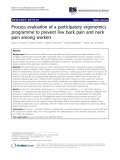
Back and neck pain
-
As science and technology has developed, the manner by which drugs can be delivered has grown. Medicines may be taken orally, applied as topical pastes, creams or oils, patches or administered by direct injection to the body. This research explores an alternative method for the delivery of therapeutic compounds to the body. The basis of the study involves the application of traditional medicinal compounds used to cure minor neck and back pains through transdermal topical application, using a textile substrate as the carrier.
 128p
128p  runthenight07
runthenight07
 01-03-2023
01-03-2023
 10
10
 3
3
 Download
Download
-
Tuyển tập báo cáo các nghiên cứu khoa học quốc tế ngành y học dành cho các bạn tham khảo đề tài: Process evaluation of a participatory ergonomics programme to prevent low back pain and neck pain among workers
 11p
11p  toshiba22
toshiba22
 22-11-2011
22-11-2011
 53
53
 6
6
 Download
Download
CHỦ ĐỀ BẠN MUỐN TÌM














